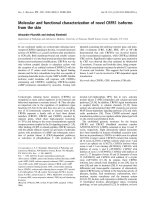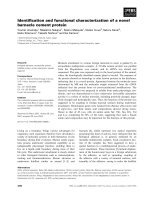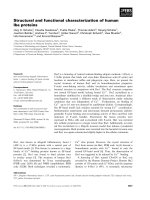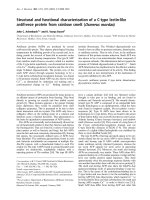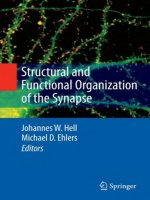Structural and functional characterization of haditoxin, a novel neurotoxin isolated from the venom of ophiohagus hannah (king cobra
Bạn đang xem bản rút gọn của tài liệu. Xem và tải ngay bản đầy đủ của tài liệu tại đây (13.99 MB, 308 trang )
STRUCTURAL AND FUNCTIONAL CHARACTERIZATION OF
HADITOXIN, A NOVEL NEUROTOXIN ISOLATED FROM THE
VENOM OF OPHIOPHAGUS HANNAH (KING COBRA)
A THESIS SUBMITTED
FOR THE DEGREE OF DOCTOR OF PHILOSOPHY
AMRITA ROY
M. Pharm.
Pharmaceutical Technology
DEPARTMENT OF BIOLOGICAL SCIENCES
FACULTY OF SCIENCE
NATIONAL UNIVERSITY OF SINGAPORE
AUGUST, 2011
ii
Dedication
DedicationDedication
Dedication
This
This This
This thesis
thesisthesis
thesis
is dedicated to my parents
is dedicated to my parentsis dedicated to my parents
is dedicated to my parents
Mrs
MrsMrs
Mrs.
.
Subhra Roy
Subhra Roy Subhra Roy
Subhra Roy
and
and and
and
Mr. Haridas Roy
Mr. Haridas RoyMr. Haridas Roy
Mr. Haridas Roy
who
who who
who taught me the value of education
taught me the value of educationtaught me the value of education
taught me the value of education
iii
PREFACE
This dissertation would not have been possible without the guidance and the help
of several individuals who in one way or another contributed and extended their
valuable assistance in the preparation and completion of this study.
First and foremost, I would like to thank my supervisor Professor R. Manjunatha
Kini for his constant encouragement, critical comments and enlightening ideas
throughout this study. I feel fortunate to be supervised by Prof. Kini, who not only
taught me most of what I know about protein chemistry, but also about how to
think and work independently. The best thing I have enjoyed in his lab is the
freedom of thinking and designing my own experiments, which contributed a lot
to develop my skills to become an independent researcher over the past few years.
I owe a great debt of gratitude to Dr. Selvanayagam Nirthanan (Niru) for his
valuable suggestions and constant motivation. He has been a kind, humble and
patient person who helped me whenever it was needed. His useful suggestions
during the manuscript preparation are not only reflected in the published article
but will also influence the way I write in future. Undoubtedly, his direction and
encouragement have played a significant role in many aspects of my research.
I would like to thank the graduate program run by the National University of
Singapore for their financial support for the past four years. Additionally, I thank
the Biomedical Research Council (BMRC) of Singapore, for providing a generous
grant to Prof. Kini which funded my work described in this thesis.
All this work would not have been possible without the support of our able
collaborators. I would like to thank Assoc. Professor J. Sivaraman, for helping me
out structural characterization part of my project. I am extremely thankful to
Professor Daniel Bertrand for helping me out with all the electrophysiology
experiments. His insightful suggestions have greatly improved the contents of this
thesis and well as my research publications. My hearty thanks to Professor Palmer
iv
Taylor and all his lab members who has kindly allowed me to work in their lab for
a few days to perform the experiments with the binding protein. My sincere thank
goes to Assoc. Professor Anders Asbjørn Jensen for helping me with the
experiments related to 5HT
3
receptors.
I would like to thank all the teachers who made a difference in my life by their
contributions. I would like to thank Professor Tuhinadri Sen, Professor Dwijen
Sarkar, Dr. V. Rajan, Dr. Samir Samanta, Paul Sir, Mr. Goutam Banerjee for their
support and inspiration.
Thanks to all the people that make the Department run so smoothly. Thanks to
Joanne, Reena, Mrs Chan and Priscilla. Special thanks go to Annie for helping us
to design the beautiful cover page illustration for the Journal of Biological
Chemistry, March 2010 issue.
I would like to thank all the past and present lab mates for making my stay fun
and entertaining. Thanks to Dr. Rajagopalan Nandakishore, for the initial
guidance during my first semester in the lab and for all the valuable discussions.
Thanks to Dr. Cho Yeow for teaching me HPLC and Dr. Raghurama Hegde, for
helping me to draw and modify the structures of macromolecules, Dr. Robin
Doley for teaching me the basic steps in molecular biology. I would also like to
thank Dr. Ryan, Dr. Reza, Dr. Guna Shekhar, Dr. Pushpalatha, Dr. Alex, Shiyang,
Tzer Fong, Ee Xuan, Ming Zhi, Bee Har, Maulana, Shifali, Sindhuja, Angie, Aldo,
Nazir, Summer, Bidhan and Varuna for all the help they have done. I would like
to thank Ms. Tay Bee Ling for maintaining the lab finances and making sure we
get things on time. In addition, I would also like to thank all the members of the
Structural Biology lab (S3-04) for their constant help. My thanks extend to Mrs.
Ting, Department of Pharmacology, NUS who has always been helpful during my
experiments in the pharmacology department. I would also like to thank my
friends Pradipta and Tanay from the Department of Chemistry, NUS for their help
in many of my experiments.
v
It has indeed been a pleasure to have had the acquaintance of Ms. Sheena (Shins,
that’s how I address her). She has not only helped me with the pharmacological
studies but also the long never-ending discussions with her have significantly
contributed towards my understanding of in vivo and in vitro pharmacology. I
would also like to thank Ms. Angelina who is an IT expert to me. She has always
shared a hand for all my editing business. She is also the one planning for all our
outings for a change of our routine lab work. I will definitely miss the exciting
lunch and dinner dates with the two of them.
My special thanks go to Bhaskar and Garvita who has always been a help in my
difficult times. Thanks for spreading their infectious enthusiasm especially for the
charming coffee sessions.
It would be futile to even attempt to thank my colleague and friend, Girish, Vivek
and Jhinuk. They have been a pillar of support throughout my time in Singapore
in my personal as well as academic life. I truly thank the Almighty for providing
me such unforgettable friends.
I am grateful to my family for their support and believe on me. Thanks to my
grandmother Mrs. Amita Chatterjee, my father Mr. Haridas Roy and my mother
Mrs. Subhra Roy, my in-laws Mr. Pratap Sarkar and Mrs. Namita Sarkar, my
sisters Ms. Adrita Roy, Jyotsna di, Ms. Sudipta Sarkar, my brother Mr. Jit
Chatterjee, Mr. Daipayan De, my uncle Late Mr. Paramananda Roy who saw me
through difficult times and will now rejoice with me on achieving this academic
milestone.
Above all, I am extremely thankful to my husband, Mr Debraj Sarkar for being
my pillar of strength and support. I would not have come so far without his
motivation and also my apologies for releasing my frustration on him which he
endured quite patiently.
And there are plenty of other friends and colleagues too numerous to mention who
have helped me in some way or the other. I greatly appreciate all of them!
vi
Finally, I am grateful to God, who has moved in mysterious ways, but always
with my best interests at heart.
Last but not the least, I would like to thank the king cobra, who has supplied the
venom for my research in the Kentucky Reptile Zoo, USA and Mr. Kristen for
sending me that venom. I would also like to thank all the chicks and rats who had
sacrificed their life for the sake of pharmacology experiments related to this thesis.
Amrita Roy
August, 2011
vii
TABLE OF CONTENTS
Page
Dedication ii
Preface iii
Table of contents vii
Summary xii
Research collaborations xv
List of publications xvi
List of figures xx
List of tables xxv
Abbreviations xxvi
CHAPTER ONE: INTRODUCTION 1
1.1 Poisons to potions 2
1.2 The enigmatic serpents: Snakes 5
1.2.1 Ophiophagus hannah: King of the serpents 6
1.3 Snake venom: the complex mixture 9
1.4 Three-finger toxin (3FTX) family 14
1.5 The ubiquitous three-finger fold 18
1.6 Three-finger toxins interacting with the cholinergic systems 19
1.6.1 Muscarinic toxins 19
1.6.2 Fasciculins 22
1.6.3 Neurotoxins 24
1.7 Nicotinic acetylcholine receptors 28
1.8 Subtypes of nAChRs 33
1.8.1 Muscular type of nAChRs 33
1.8.2 Neuronal type of nAChRs 34
1.9 The ligand binding domain of nAChRs 40
1.10 Acetylcholine binding protein (AChBP) 41
1.11 Nicotinic acetylcholine receptors: Allosteric properties 48
1.12 The scope for nicotinic acetylcholine receptor ligands 49
viii
1.13 Aim and scope of the thesis 50
CHAPTER TWO: ISOLATION AND PURIFICATION OF
HADITOXIN 52
2.1 INTRODUCTION 52
2.2 MATERIALS AND METHODS 55
2.2.1 Materials 55
2.2.2 Sequence analysis 55
2.2.3 Protein purification from crude venom 55
2.2.4 Molecular mass determination 56
2.2.5 N-terminal sequencing 57
2.2.6 Capillary electrophoresis 57
2.2.7 CD spectroscopy 57
2.3 RESULTS 78
2.3.1 Isolation and purification of haditoxin 59
2.3.2 Identification of haditoxin 62
2.3.3 Assessment of homogeneity of haditoxin 62
2.3.4 Secondary structure analysis of haditoxin 65
2.4 DISCUSSION 66
2.5 CONCLUSIONS 81
CHAPTER THREE: PHARMACOLOGICAL
CHARACTERIZATION OF HADITOXIN 82
3.1 INTRODUCTION 82
3.2 MATERIALS AND METHODS 85
3.2.1 Drugs and chemicals 85
3.2.2 Animals 85
3.2.3 Methods of protein administration 86
3.2.4 In vivo toxicity study 86
3.2.5 Determination of LD
50
87
3.2.6 Ex vivo organ bath studies 87
3.2.7 Reversal studies 88
ix
3.2.8 Rat ileum preparations 90
3.2.9 Rat annococcygeus muscle preparation 91
3.2.10 Rat phrenic nerve henidiaphragm muscle preparation 92
3.2.11 Chick biventer cervicis muscle preparation 93
3.2.12 Statistical analysis 96
3.2.13 Electrophysiological characterization of haditoxin 96
3.2.14 Oocyte preparation and cDNA injection 96
3.2.15 Electrophysiological recording 97
3.2.16 Electrophysiological data analysis 98
3.3 RESULTS 99
3.3.1 Effect of haditoxin on cholinergic transmission
mediated by muscarinic receptors 99
3.3.2 Biological activity of haditoxin in mice 100
3.3.3 Lethality of haditoxin in mice 100
3.3.4 Effect of haditoxin on the cholinergic transmission
mediated by nicotinic receptors 104
3.3.5 Effect of haditoxin on neuromuscular transmission
in CBCM 114
3.3.6 Effect of haditoxin on neuromuscular transmission
in RHD 108
3.3.7 Reversal of neuromuscular blockade produced
by haditoxin 110
3.3.8 Effect of haditoxin on human nAChRs 110
3.4 DISCUSSION 121
3.5 CONCLUSIONS 127
CHAPTER FOUR: BIOPHYSICAL AND STRUCTURAL
CHARACTERIZATION OF HADITOXIN 128
4.1 INTRODUCTION 128
4.2 MATERIALS AND METHODS 131
4.2.1 Proteins and reagents 131
4.2.2 Gel filtration chromatography 131
x
4.2.3 CD spectroscopy 132
4.2.4 Electrophoresis 132
4.2.5 Crystallization of haditoxin 133
4.2.6 X-ray diffraction and data collection 133
4.3 RESULTS 134
4.3.1 Haditoxin is a dimer 134
4.3.2 X-ray crystal structure of haditoxin 135
4.3.3 Structure determination and refinement 140
4.3.4 Dimeric interface 143
4.4 DISCUSSION 150
4.5 CONCLUSIONS 165
CHAPTER FIVE: STRUCTURE-FUNCTION RELATIONSHIPS
OF HADITOXIN 166
5.1 INTRODUCTION 166
5.2 MATERIALS AND METHODS 169
5.2.1 Reagents and kits 169
5.2.2 Radioligand binding assay with acetylcholine
binding protein 170
5.2.3 Ca
2+/
Fluo-4 assay on 5-HT
3
receptors 171
5.2.4 Bacterial strains and plasmids 172
5.2.5 Cloning of haditoxin gene into pLICC plasmid 174
5.2.6 Sequence analysis 174
5.2.7 Recombinant protein expression 175
5.2.8 Extraction of the recombinant protein 175
5.2.9 Affinity purification 176
5.2.10 Purification of the cleaved protein using RP-HPLC 177
5.2.11 Mass determination 178
5.2.12 Ex vivo organ bath studies recombinant haditoxin 178
5.2.13 Statistical analysis 178
5.3 RESULTS 180
5.3.1 Interaction of haditoxin with AChBP 180
xi
5.3.2 Interaction of haditoxin with 5-HT
3
receptors 180
5.3.3 Recombinant expression and purification of haditoxin 182
5.3.4 Functional characterization of haditoxin using CBCM 190
5.4 DISCUSSION 193
5.5 CONCLUSIONS 197
CHAPTER SIX: CONCLUSIONS AND FUTURE PERSPECTIVE 198
6.1 CONCLUSIONS 198
6.2 FUTURE PERSPECTIVE 202
6.2.1 Role of the dimeric structure of haditoxin
towards neuromuscular blockade 202
6.2.2 Novel structural elements of haditoxin to interact
with α
7
-nAChR 202
6.2.3 Binding mode of haditoxin to α
7
-nAChR 203
6.2.4 Structural determinants of haditoxin
conferring reversibility 203
6.2.5 Kinetics of interaction between haditoxin and
neuronal receptors 204
Bibliography 205
Appendix 239
Publications 241
xii
SUMMARY
Snake venoms are a rich source of pharmacologically active proteins and
polypeptides, targeting a variety of receptors, which includes several potent and
lethal neurotoxins. This family contains several types of neurotoxins that interact
with different subtypes of nicotinic and muscarinic receptors involved in central
and peripheral cholinergic transmission. They are being potentially used by the
researchers as molecular probes to characterize different subtypes of cholinergic
receptors.
In this study, we report the purification, structural and functional characterization
of a novel non-covalent homodimeric neurotoxin, haditoxin, from the venom of
Ophiophagus hannah (king cobra). This protein was first identified in a cDNA
library from the venom gland mRNA of O. hannah. Haditoxin was purified to
homogeneity from the venom using a two-step chromatography approach. The
protein consists of 65 amino acid residues with four intramolecular disulfide
bonds. From the cysteine scaffold it was concluded that this protein belong to the
three-finger toxin family of snake venom proteins.
Haditoxin produced a potent postsynaptic neuromuscular blockade on avian and
mammalian muscle preparations and the reversibility of the blockade was species-
specific. In the elctrophysiological studies with expressed human nicotinic
receptors haditoxin exhibited novel pharmacology with antagonism towards
muscle (αβγδ) and neuronal (α
7
, α
3
β
2
and α
4
β
2
) nicotinic acetylcholine receptors
(nAChRs), with highest affinity for α
7
-nAChRs. The high resolution (1.55 Å)
xiii
crystal structure revealed haditoxin as a non-covalent dimer with two identical
subunits in a three-finger protein fold, which correlates well with the biophysical
studies. Each of the monomer adapted a structure similar to the short-chain α-
neurotoxins, with four intramolecular disulfide bridges, such as- erabutoxin,
which interacts specifically with muscle (αβγδ) nAChRs. However, the
quaternary structure is similar to that of κ-neurotoxins such as κ-bungarotoxin,
which interact specifically with neuronal (α
3
β
2
and α
4
β
2
) nAChRs. Clearly
haditoxin shows unique structural and functional profiles. Haditoxin is the first
dimeric neurotoxin to interact with the muscle nAChR as well as the first short-
chain α-neurotoxin to interact with neuronal α
7
-nAChR with nanomolar affinity.
Interestingly however, haditoxin lacked the helix-like segment cyclized by the
fifth disulfide bridge at the tip of loop II of long-chain α-neurotoxins, hitherto
considered critical for binding to neuronal α
7
-receptors. It is therefore likely that
haditoxin, which shares a common tertiary fold with α-neurotoxins and κ-
neurotoxins may have other functional determinants for recognizing neuronal α
7
-
receptors.
Finally, we have successfully expressed recombinant haditoxin which had also
exhibited potent neuromuscular blockade. Further structure-function relationship
studies are in progress. Delineating the structure-function relationship of this
protein will help us to understand in great detail how a dimeric neurotoxin interacts
with muscle nicotinic receptors as well as to identify the novel structural elements
responsible for binding of a neurotoxin with neuronal nicotinic receptors. Thus, the
novel ligand, haditoxin can lead to opening of new avenues for future studies that
xiv
can contribute to greater understanding of the biology of the nicotinic
acetylcholine receptors.
xv
RESEARCH COLLABORATIONS
The following laboratories provided invaluable experimental data which is
discussed in this thesis. Their contribution is gratefully acknowledged.
Electrophysiology studies on haditoxin
Professor Daniel Bertrand and Dr. Dieter D’hoedt.
Department of Physiology, Centre Medical Universitáire, University of Geneva,
1 Rue Michel Servet, 1211 Geneva 4, Switzerland.
Crystallographic studies on haditoxin
Associate Professor Jayaraman Shivaraman and Dr. Xingding Zhou.
Structural Biology Laboratory 5, S3-04,
Department of Biological Sciences, National University of Singapore.
Singapore.
Radioligand binding studies of haditoxin with AChBP
Professor Palmer Taylor, Dr Todd Talley, Dr. Zoran Radic, Mr. Akos Nemecz
and Ms Joannie Ho.
Skaggs School of Pharmacy and Pharmaceutical Sciences,
University of California, San Diego,
9500 Gilman Drive, La Jolla, California 92093, USA.
Interaction studies of haditoxin with 5-HT
3
receptors
Associate Professor Anders Asbjørn Jensen.
Faculty of Pharmaceutical sciences, University of Copenhagen,
Universitetsparken 2, 2100 Copenhagen, Denmark.
xvi
PUBLICATIONS
RESEARCH ARTICLES
(1) Mani Senthil Kumar KT, Gorain B, Roy DK, Zothanpuia, Samanta SK,
Pal M, Biswas P, Roy A, Adhikari D, Karmakar S and Sen T. Anti-
inflammatory activity of Acanthus ilicifolius. J Ethnopharmacol. 2008 Oct
30;120(1):7-12.
(2) Samanta SK, Kumar KT, Roy A, Karmakar S, Lahiri S, Palit G,
Vedasiromoni JR and Sen T., An insight on the neuropharmacological
activity of Telescopium telescopium a mollusc from the Sunderban
mangrove. Fundam Clin Pharmacol. 2008 Dec;22(6):683-91.
(3)
Roy A, Zhou X, Chong MZ, D'hoedt D, Foo CS, Rajagopalan N, Nirthanan S,
Bertrand D, Sivaraman J and Kini RM., Structural and functional characterization
of a novel homodimeric three-finger neurotoxin from the venom of Ophiophagus
hannah (king cobra). J Biol Chem. 2010 Mar 12;285(11):8302-15. (Selected as
“Paper of the Week” and for the cover page illustration for the March 12, 2010
issue of the JBC)
(4) Roy A, Rajagopalan N, and Kini RM. Identification and characterization
of a α-helical molten globule intermediate of β-cardiotoxin, an all β-sheet
protein isolated from the venom of Ophiophagus hannah (king cobra).
Manuscript under preparation.
xvii
(5) Roy A,
Sivaraman J
, and Kini RM. Structural and functional
characterization of a novel weak neurotoxin from the venom of
Ophiophagus hannah (king cobra). Manuscript under preparation.
INTERNATIONAL CONFERENCE PRESENTATIONS & SYMPOSIUMS
(1) Structural and Functional Characterization of a Novel Homodimeric
Three-finger Neurotoxin from the Venom of Ophiophagus hannah (King
Cobra). (Poster presentation) Amrita Roy, Xingding Zhou, D’hoedt
Dieter, Ming Zhi Chong, Chun Shin Foo, Nandhakishore Rajagopalan,
Selvanayagam Nirthanan, Daniel Bertrand, J Sivaraman, R. Manjunatha
Kini ; 6th International Conference on Structural Biology & Functional
Genomics. Singapore, December 6 - 8, 2010. Received the Best Poster
award.
(2) Structural and Functional Characterization of a Novel Homodimeric
Three-finger Neurotoxin from the Venom of Ophiophagus hannah (King
Cobra). (Poster presentation) Amrita Roy, Xingding Zhou, D’hoedt
Dieter, Ming Zhi Chong, Chun Shin Foo, Nandhakishore Rajagopalan,
Selvanayagam Nirthanan, Daniel Bertrand, J Sivaraman, R. Manjunatha
Kini ; The 24th Annual Symposium of the Protein Society. San Diego,
USA, August 1 - 5, 2010.
xviii
(3) Structural and functional characterization of a novel homodimeric three-
finger neurotoxin from the venom of Ophiophagus hannah (King cobra).
(Oral presentation) Roy A, Zhou X, Chong MZ, D'hoedt D, Foo CS,
Rajagopalan N, Nirthanan S, Bertrand D, Sivaraman J and Kini RM.; 14th
Biological Sciences Graduate Congress. Bangkok, Thailand, December 10
- 12, 2009.
(4) Attended the IUPAB sponsored workshop on “NMR and its applications
in Biological systems” at Tata Institute of Fundamental Research, Mumbai,
India, November 23 – 30, 2009.
(5) Isolation and characterization of a novel neurotoxic protein from the
venom of Ophiophagus hannah. (Poster presentation) Roy A, Chong MZ,
Rajagopalan N and Kini R M.; Joint 5
th
Structural Biology and Functional
Genomics and 1
st
Biological Physics International Conference. Singapore,
December 9 - 11, 2008.
(6) Isolation and characterization of a novel neurotoxic protein from the
venom of Ophiophagus hannah. (Poster presentation) Roy A, Chong MZ,
Rajagopalan N and Kini R M.; 13th Biological Sciences Graduate
Congress. Singapore, December 15 - 17, 2008.
xix
(7) Biochemical studies on telescopium telescopium – a marine mollusk from
the coastal regions of west Bengal. (Poster presentation) Samir K. Samanta,
Aniruddha Roy, Arnab Datta, Amrita Roy, K.T. Manisenthil Kumar, J.R.
Vedasiromani, Dwijen Sarkar and Tuhinadri Sen.; IMBC 2007 - 8th
International Marine Biotechnology Conference. Eilat, Israel, March 11 -
16, 2007.
xx
LIST OF FIGURES
Chapter one
Figure 1.1 Ophiophagus hannah (king cobra) and its geographical distribution
Figure 1.2 Representative examples of major families of enzymatic snake venom
proteins
Figure 1.3 Representative examples of major families of non-enzymatic snake
venom proteins
Figure 1.4
Three-dimensional structural similarity among 3FTXs from snake
venoms
Figure 1.5 Functional diversity of three-finger toxins
Figure 1.6 Muscarinic toxins from mamba venom
Figure 1.7 Fasciculins
Figure 1.8 Snake toxins that interact with nicotinic acetylcholine receptors
Figure 1.9 Schematic representation of superfamilies of ligand-gated ion channels
Figure 1.10 Structure of the nicotinic acetylcholine receptors
Figure 1.11 Schematic representations of nicotinic receptor and its subtypes
Figure 1.12 Structure of Torpedo marmorata (marbled electric ray) nAChR at 4 Å
obtained by cryo-electron microscopy
Figure 1.13 Signal transmission at the neuromuscular junction (the synapse)
Figure 1.14 Molecular model of mammalian (rat) α7 nicotinic receptor
Figure 1.15 Representation of the ligand binding site and the ion channel of the
nicotinic receptors
Figure 1.16 The acetylcholine binding protein (119B) from Lymnaea stagnalis
Figure 1.17 Three dimensional structure of the α-cobratoxin (Cbtx)-AChBP complex
Figure 1.18 Close up view of a single AChBP subunit and the Cbtx molecule bound
at this subunit interface (1YI5)
Chapter two
Figure 2.1 Gel filtration chromatogram of O. hannah crude venom
xxi
Figure 2.2 RP-HPLC profile of peak 2 from gel filtration chromatography
Figure 2.3 ESI-MS spectrum of the RP-HPLC fraction 2a
Figure 2.4 Reconstructed ESI-MS spectrum of haditoxin
Figure 2.5 N-terminal sequencing of haditoxin
Figure 2.6 Capillary electropherogram of haditoxin
Figure 2.7 Circular dichroism spectrum of haditoxin
Figure 2.8 Comparison of the amino acid sequence of haditoxin with the sequences
of other three-finger toxins
Figure 2.9 Sequence alignment of haditoxin with the most homologous sequences of
other three-finger toxins
Figure 2.10 Sequence alignment of haditoxin with the sequences of muscarinic toxins
and their homologs
Figure 2.11 Comparison of the amino acid sequence of haditoxin with the conserved
sequences of muscarinic toxins
Figure 2.12: Sequence alignment of haditoxin with the sequences of short-chain α-
neurotoxins
Figure 2.13: Sequence alignment of haditoxin with the sequences of long-chain α-
neurotoxins
Figure 2.14: Sequence alignment of haditoxin with the sequences of non-conventional
neurotoxins
Figure 2.15: Sequence alignment of haditoxin with the sequences of reversible
neurotoxins and neurotoxin homologs
Figure 2.16: Sequence alignment of haditoxin with the sequences of κ-neurotoxins
Figure 2.17: Sequence alignment of haditoxin with the sequences of covalent dimeric
neurotoxins and cytotoxins
Chapter three
Figure 3.1 Schematic representation of the organ bath experimental setup used for
studies of isolated tissues
xxii
Figure 3.2 Effect of haditoxin on the cholinergic transmission in the smooth muscle
of rat ileum
Figure 3.3 Effect of haditoxin on the cholinergic transmission in rat anococcygeus
muscle
Figure 3.4 Determination of LD
50
of haditoxin
Figure 3.5 Figure 3.5: Effect of haditoxin on the twitch response of CBCM elicited
by nerve stimulation and exogenously applied acetylcholine, carbachol
and potassium chloride
Figure 3.6 Dose-response curve of haditoxin and α-bungarotoxin on CBCM and
RHD
Figure 3.7 Effect of haditoxin on the twitch response of RHD elicited by nerve
stimulation
Figure 3.8 Reversibility of the nerve evoked twitch response blockade produced by
haditoxin in CBCM
Figure 3.9: Reversibility of the nerve evoked twitch response blockade produced by
haditoxin in RHD
Figure 3.10: Reversibility of the nerve evoked twitch response blockade produced by
haditoxin in CBCM by neostigmine
Figure 3.11: Comparitive reversibility profile of haditoxin, α-bungarotoxin and
candoxin on CBCM
Figure 3.12: Effect of haditoxin on human αβδε-nACHRs expressed in Xenopus
oocytes.
Figure 3.13: Effect of haditoxin on human α
7
-nACHRs expressed in Xenopus
oocytes
Figure 3.14: Effect of haditoxin on human α
3
β
2
-nACHRs expressed in Xenopus
oocytes
Figure 3.15: Effect of haditoxin on human α
4
β
2
-nACHRs expressed in Xenopus
oocytes
xxiii
Chapter four
Figure 4.1 Dimerization of haditoxin observed in gel filtration studies
Figure 4.2 Tris-tricine SDS-PAGE analysis of haditoxin for dimerization
Figure 4.3 Refolding of CM18 and β-cardiotoxin after thermal
denaturation
Figure 4.4 2Fo-Fc map of haditoxin
Figure 4.5 Overall crystal structure of haditoxin
Figure 4.6 Structure based alignment of haditoxin with other three finger toxins
Figure 4.7 Superimposition of both the subunits of haditoxin
Figure 4.8 Superimposition subunit A of haditoxin with short-chain α-neurotoxins
Figure 4.9 Stereo diagram of the dimeric interface of haditoxin
Figure 4.10 Superimposition subunit A of haditoxin with α-cobratoxin
Figure 4.11 Critical residues for α-cobratoxin and haditoxin to interact with α7-
nAChRs
Figure 4.12 Superimposition subunit A of haditoxin with candoxin
Figure 4.13 Haditoxin vs κ-bungarotoxin
Figure 4.14 Stereo diagram of comparison of dimer interface of haditoxin and κ-
bungarotoxin
Figure 4.15 Comparison of the electrostatic surface of haditoxin and κ-
bungarotoxin
Figure 4.16 Structural comparison of haditoxin and irditoxin
Chapter five
Figure 5.1 Schematic representation of the (A) plasmid pLICC and (B)
pLICC:Haditoxin
Figure 5.2 Interaction of haditoxin with acetylcholine binding protein and mutants
Figure 5.3 Dose-dependent inhibition curve of haditoxin on 5-HT
3
A receptors
Figure 5.4 SDS-PAGE picture showing over-expression and affinity purification
of recombinant haditoxin
Figure 5.5 SDS-PAGE picture showing TEV cleavage of recombinant haditoxin
xxiv
Figure 5.6 RP-HPLC profile of recombinant haditoxin
Figure 5.7 ESI-MS spectrum of the recombinant haditoxin
Figure 5.8 Effect of recombinant (r) haditoxin on the twitch response of CBCM
elicited by nerve stimulation and exogenously applied acetylcholine,
carbachol and potassium chloride
Figure 5.9 Dose-response curve of recombinant haditoxin on CBCM
xxv
LIST OF TABLES
Chapter one
Table 1.1 Enzymatic proteins from snake venoms
Table 1.2 Non-enzymatic proteins from snake venoms
Table 1.3 Intermolecular interactions between α-cobratoxin and AChBP
Chapter three
Table 3.1 Biological effects of haditoxin injected intraperitoneally into Swiss
albino mice
Table 3.2 Effect of haditoxin on human nicotinic receptors expressed in
Xenopus oocytes
Chapter four
Table 4.1 X-ray data collection and refinement statistics
Table 4.2 Hydrogen bonds in the dimeric interface of haditoxin
Chapter five
Table 5.1 Interaction of the Haditoxin with human 5-HT
3
A and 5-HT
3
AB
receptors




